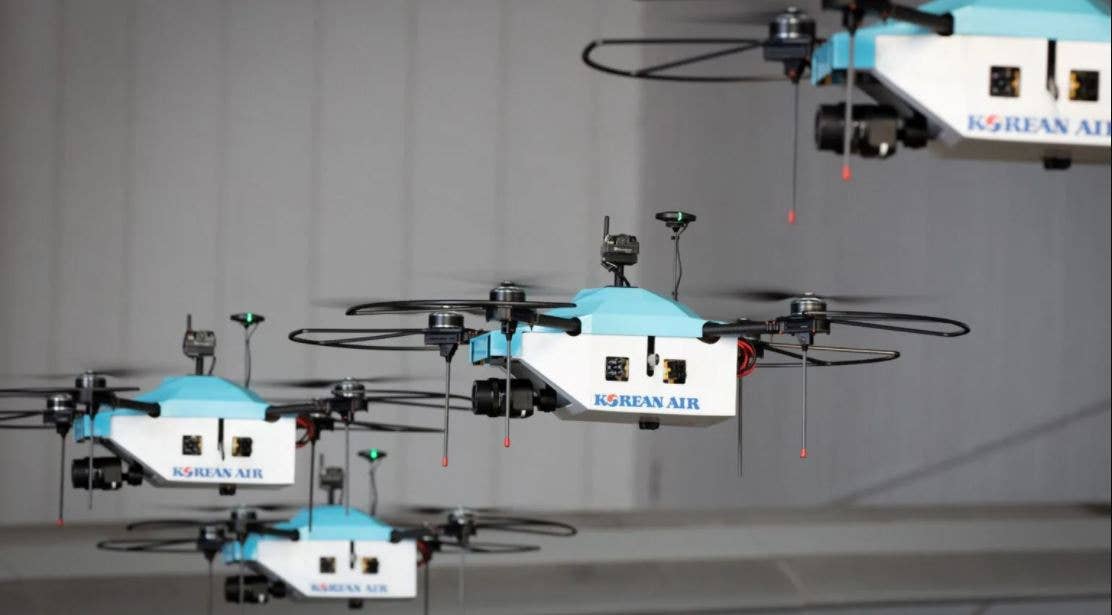Korean Air Develops Drone Swarm Technology to Inspect Aircraft
Airline says remotely piloted vehicles can reduce out-of-service time by as much as 60 percent.

Korean Air plans to use drone swarms to inspect aircraft. [Photo: Korean Airlines]
Editor’s Note: This article originally appeared on FreightWaves.com.
One of the latest applications for drones is inspecting aircraft for damage and wear during maintenance inspections. Korean Air is taking the concept to the next level by using multiple robot aircraft to make the work faster and easier.
The airline says it has developed technology that for the first time allows a swarm of drones to inspect an aircraft exterior. Last week it demonstrated the concept on one of its aircraft inside a hangar in Seoul.
Four unmanned aerial vehicles have been programmed to simultaneously take photos of preplanned areas of an airplane. If one of the drones fails to operate, the system is configured to automatically complete the mission using the remaining UAVs.
Why This Matters
Drone inspections are attracting interest from airlines, maintenance and repair organizations, and leasing companies. Global aviation regulations require airlines to periodically conduct visual checks of the fuselage. Manually checking the upper section of a transport category airplane is challenging and requires lift equipment. Drones can conduct the inspections with a greater degree of safety—as well as with increased accuracy and speed—while eliminating subjectivity, developers say.
Drone inspections can reduce the amount of time an aircraft is out of service, helping airlines maintain schedules and ensure revenues. Using remotely piloted aircraft after a lightning strike, for example, could allow an airline to quickly determine if there is any damage without having to pull an airplane into a hangar, according to maintenance experts.
Korean Air said a drone swarm can visually inspect an aircraft in about four hours compared to 10 hours for human inspections. The drones, equipped with high-performance cameras, can identify objects up to 1 millimeter in size, allowing for detection of tiny defects that can’t be seen from above with the naked eye.
The inspection data is shared through the cloud, enabling employees to easily check inspection results anywhere and anytime. The airline has also applied a collision-avoidance system and geo-fencing to maintain safety distances from surrounding facilities and prevent drones from breaking away from the mission area.
Korean Air said it will work to perfect safety and worker interfaces, stabilize operations, and increase inspection accuracy through continuous trials before officially deploying inspection drones next year.
Another Player in the Game
Another company focused on drone inspection of aircraft is Mainblades. In August, the drone developer conducted a fully automated outdoor airport inspection of an Airbus A330 at an active airport in the EU. It was the first time such an inspection has been conducted on the continent, according to the company.
The inspection took place at an air base in Woensdrecht, the Netherlands.
Mainblades currently operates inside hangars owing to airport limitations regarding the use of drones, but said it continues to validate the case for outdoor airport inspections.
“If an aircraft lands, and it is damaged on the way, for example by lightning or birds, it must now first go to a closed location such as a hangar. That way you lose a lot of time. Besides this, hangar space is expensive to rent and not always available,” which makes open-air inspections an attractive alternative, Dejan Borota, co-founder and director of Mainblades, said in a blog post on the company’s website.
The outdoor test enabled the company to identify obstacles and necessary procedures so it can build an operation that is scalable worldwide, he said.
Automated inspections could be useful during lease transitions, said Jack Bos, technical director at TrueNoord, an aircraft leasing company, in a video of the outdoor inspection event. Inspectors typically check aircraft to make sure all damage repairs are correctly recorded, but that can be difficult to do on top of the fuselage, empennage, or wings, he explained.

Subscribe to Our Newsletter
Get the latest FLYING stories delivered directly to your inbox






